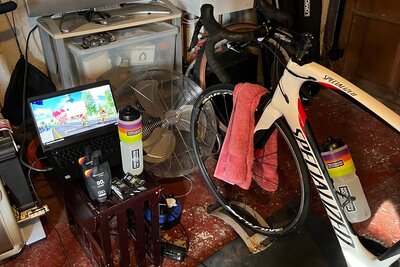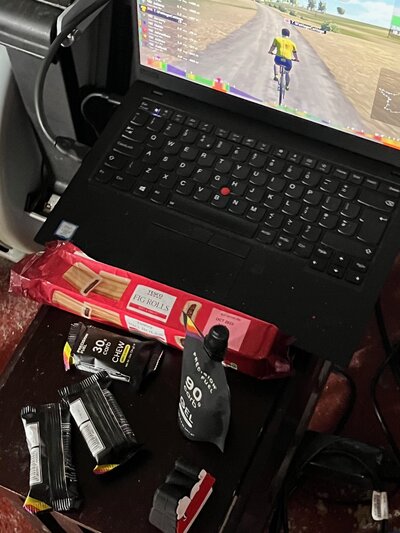Training camps have been in existence for almost as long as competitive sport has been around. Even back in Ancient Greece, hopeful athletes would often spend long periods of time away from loved ones to train or compete in the hunt for fame, fortune or just freedom. Winners were immortalised by statues (although I’d frankly just settle for a few more watts in the saddle).
Despite a couple of decades or so of endurance sport behind me, I’ve never actually found the time to go on a training camp. Therefore, before I’m on the downslope that involves elasticated waistbands and ‘going for walks’, I decided that this year was the time to give one a go myself.
Rather than head to sunnier climes, I tried something a little different by taking a week off work and undertaking a DIY training camp from the 'comfort' of my own home. Here's what I learned...
Lesson #1
"Know why you’re going and what you’re hoping to achieve."
The basic reasons for such camps seemingly vary from the sociological (i.e. ‘let’s have a fun time riding bikes’), to the technological ('let’s test a load of new equipment'), through to the physiological (‘I’m going to win the next Tour de France!').
In essence, training camps are an intensive programme of compacting a larger than normal volume of training to improve fitness, technique, and performance, without the additional stresses and strains of everyday life. The key word here is volume.
Whilst plenty of studies will argue what dose or type of training volume is optimal, the bottom line is that a ‘high’ training volume has been associated with a faster finishing time for sports such as long distance running - provided some care is taken with recovery.

In my own case, I had seven days off work and was looking to top-up and finish off my winter training by adding one last big dollop of volume, whilst also doing specific work for upcoming gravel races.
Lesson #2
“Never stand up when you can sit down, and never sit down when you can lie down.” Sir Winston Churchill (amongst others)
I then also took the rather unusual approach of performing it all on the indoor trainer and using online apps. Before my sanity is questioned here, there were practical reasons for doing this. Having always suffered from saddle sores after long rides, I experienced something of a revelation during the lockdown of the 2020 global pandemic as that I found that I never had this same issue when riding indoors.
Secondly, with no junctions, coasting or stops, I knew that for the same time elapsed, I could get roughly 20% more training done for the same time by doing it on the turbo.
Lastly, the weather in the UK in April can be erratic and for every minute spent getting dressed for the conditions was a minute taken away from me lying on the couch and recovering... and that’s the big difference between training conventionally or being on a camp – stress and recovery.

You might be amazed at how much background stress you're subjected to when dealing with the day-to-day tasks of life, as well as how much easier things get when all you have to do is stagger from bike to shower to sofa.
This is all about energy saving – your energy. Psychologists have long since known that stress affects your wellbeing and ultimately your immune system.
Lesson #3
"Identify what you need, plan it, stick to it."
Physiologically speaking, training camps can be physically demanding. This is really kind of the point and is also where things get a little tricky in their planning. Knowing how much you can handle or should attempt can make the difference in terms of how much form, fatigue, freshness or just plain illness could spiral out of such an endeavour.
The International Olympic Committee performed a review study into the links between excessive training loads caused by aspects such as training camps and its links to illness. Whilst they couldn’t be specific in how much training load was too great, they obtained consensus that if you do too much or do something too hard and for too long, your immune system is reduced and this leaves you more susceptible to illness.
I was acutely aware of this because, in the words of the great Clint Eastwood, “a man’s got to know his limitations”. Sites such as TrainingPeaks have tried to propose a set of anecdotal guidelines on this very topic. However, at face value, their suggested training loads are arbitrary and seemingly based on their coaching experiences. There’s nothing wrong with that but it may not line up with your own needs.
Therefore, the appropriate load depends on your goals, training background and your training load during the weeks leading up to the camp. In my own case, my typical 4-6 weeks leading into this had seen me holding around 12 hours per week, based over six sessions with a day off.
Based on that, I do use a lot of metrics to track what I do, such as ‘functional threshold power’ (FTP), ‘critical training load’ (CTL) and ‘training stress score’ (TSS), which are all via the work of Dr Andrew Coggan and Hunter Allen.
Having spoken to a few coaches beforehand to get a second opinion, it was felt that a 10-point increase in my CTL over the week was a challenging, but broadly achievable, increase in training load.
In real terms, this meant taking my current 12 hours a week of training and doubling it to 24 (or taking my typical weekly TSS of 600-700 and achieving around 1000-1100 for my week).
Lesson #4
“The best predictor of performance is performance itself.” Dr Andy Coggan
Something else I’d been curious about was to try and see what any rate of performance improvement would be like from doing this. Some physiological aspects such as an increase in blood volume can be quick – often within 24-48 hours. However, you’re also battling the accumulating fatigue of your sessions and, as we know, it’s the period of recovery when your body super-compensates.
This means that it may be some days or even weeks (depending on the type and severity of your camp) before you see any gains. In my own case, I did want to measure what was going on. So, immediately prior to my camp, I undertook what remains my de facto test for my time trialling – a 20 minute all-out test in the form of a local 10-mile time trial. I would do the same a week after it and another three weeks after that.
Lesson #5
"Tis not a man, tis a remorseless eating machine”. Captain McAllister (The Simpsons)
The next one is to forget weight loss and certainly any mention of the word ‘dieting’ when it comes to a training camp. With fatigue going to dictate how achievable the next day’s session was even going to be in the first place, attention paid to sensible and pre-planned fueling and post-session recovery was absolutely crucial.
To plan for this, I looked back at my past history to see how many calories I would burn in sessions of similar intensity and length, whilst utilising the PF&H Knowledge Hub and Fuel & Hydration Planner to ensure that my intake and expenditure was balanced. I also ensured my post-workout protein intake was in place to help speed recovery.

So, at the end of the day, what actually were my own gains from this?
My post-camp time trials didn't show any abnormal increase in my time trial power output, but I would attribute that to the sessions I was doing being designed to make me fitter, not faster. The specific work I’ll do later will do that.
I’d essentially raised my aerobic ceiling, but now I need to do the specific work to make the most of that higher ceiling. However, I would say that my recovery from hard sessions and races is now a lot faster than it was.
I managed to do two all-out races on back-to-back days a few weeks after the camp, both with the same power output. I also bounced back from a 120km gravel race a month later in half as many days as I’d normally need. I tracked my recovery using my resting heart rate and the power output I was able to put out in my sessions to check this.
This will mean that I can handle more volume in the future which hopefully means more adaptations and better performances to come. Ultimately though, my cycling DIY training camp proved I could get benefits from a cost-free, practical basis to get fitter and still yield positive gains that hopefully will help launch my race season. If not, I’ll settle for that statue.
